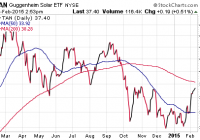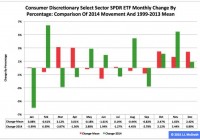Wall Street Celebrates Amazon Q2: ETFs To Benefit
After two technology giants – Apple (NASDAQ: AAPL ) and Microsoft (NASDAQ: MSFT ) – disappointed investors early in the week, Amazon (NASDAQ: AMZN ) came up with blockbuster second-quarter results after the closing bell on Thursday. This injected fresh optimism into Wall Street. The online e-commerce behemoth reported a huge earnings beat of over 200% with a bullish outlook on the third quarter. The company earned 19 cents compared to the Zacks Consensus Estimate of loss of 15 cents per share. This represents the third consecutive quarterly earnings beat for Amazon. Moreover, the company swung back to earnings from the loss of 27 cents reported in the year-ago quarter. Revenues climbed 20% year over year to $23.2 billion and were well ahead of the Zacks Consensus Estimate of $22.3 billion. Incredible performances were primarily driven by accelerating growth in the North American market, continued strength in cloud computing business and new initiatives to lure customers to fend off competition. Notably, revenues in North America grew 26% year over year while cloud computing revenue jumped 81%. The company projects revenue growth of 13-16% for the ongoing third quarter to $23.3-$25.5 billion, the midpoint is much higher than our current estimate of $23.77 billion. The guidance includes record Prime Day sales last week. Amazon also expects operating loss of $480 million to income of $70 million compared with a loss of $544 million in the same period last year. Market Impact Based on solid results and an optimistic outlook, shares of AMZN spiked as much as 19% to a new all-time high in after marker hours. This has pushed Amazon’s market cap higher to $262.7 billion, more than the market cap of $233.5 billion of the world’s largest retailer Wal-Mart (NYSE: WMT ). Including the after-market gains, the stock is up about 82% from a year-to-date look. In addition, the stock surged 22% in the pre-market session today. Impressed by Amazon’s stellar Q2 result, many analysts revised their target prices upward on the stock. Amazon, which turned 20 on July 16, has a Zacks Rank #2 (Buy) and a solid Industry rank (in the top 40%) at the time of writing as per the Zacks Industry Rank, suggesting significant upside for the stock over the coming days. Further, the stock has a Momentum Style Score of ‘A’. The smooth trading in the stock will definitely spread into the ETF world, especially the funds with the highest allocation to this Internet giant. Below we have highlighted some of these that would be in focus in the coming days: Market Vectors Retail ETF (NYSEARCA: RTH ) This fund provides exposure to the 26 largest retail firms by tracking the Market Vectors U.S. Listed Retail 25 Index. Of these, AMZN takes the top position in the basket with 10.8% share. The ETF has a certain tilt toward specialty retail, which accounts for 30% share while hypermarkets (13%), drug stores (13%) and department stores (12%) round off to the next three spots. The product has amassed $221.6 million in its asset base and charges 35 bps in annual fees. Volume is moderate as it exchanges nearly 92,000 shares per day. RTH has gained 8.6% in the year-to-date time frame and has a Zacks ETF Rank of 1 or ‘Strong Buy’ rating with a Medium risk outlook. First Trust DJ Internet Index ETF (NYSEARCA: FDN ) This is one of the most popular and liquid ETFs in the broad technology space with AUM of $3.4 billion and average daily volume of more than 320,000 shares. The fund tracks the Dow Jones Internet Composite Index and charges 54 bps in fees per year. In total, the fund holds 43 stocks with Amazon taking the second spot at 9.7%. From a sector look, Internet mobile applications account for nearly three-fifths of the portfolio while Internet retail makes up for 26%. The ETF has surged 17.4% so far this year and has a Zacks ETF Rank of 3 or ‘Hold’ rating with a High risk outlook. P owerShares NASDAQ Internet Portfolio ETF (NASDAQ: PNQI ) This fund follows the Nasdaq Internet Index, giving investors exposure to the broad Internet industry. The fund holds about 97 stocks in its basket with AUM of $224.4 million while charging 60 bps in fees per year. It trades in light volume of around 28,000 shares a day. Amazon occupies the third position with an 8.9% allocation. In terms of industrial exposure, Internet software and services makes up for 60% share in the basket, followed by Internet retail (36.1%). PNQI is up 16.1% in the year-to-date timeframe and has a Zacks ETF Rank of 4 or ‘Sell’ rating with a High risk outlook. Consumer Discretionary Select Sector SPDR ETF (NYSEARCA: XLY ) This product offers exposure to the broad consumer discretionary space by tracking the S&P Consumer Discretionary Select Sector Index. It is the largest and the most popular product in this space with AUM of nearly $11.3 billion and average daily volume of roughly 5.7 million shares. Holding 87 securities in its basket, Amazon takes the top spot with 7.7% of assets. Media dominates more than one-fourth of the portfolio while specialty retail, hotels restaurants and leisure, and Internet retail rounding off the next three spots with a double-digit allocation each. The fund has gained about 10% so far in the year and has a Zacks ETF Rank of 2 or ‘Buy’ rating with a Medium risk outlook. Link to the original post on Zacks.com

